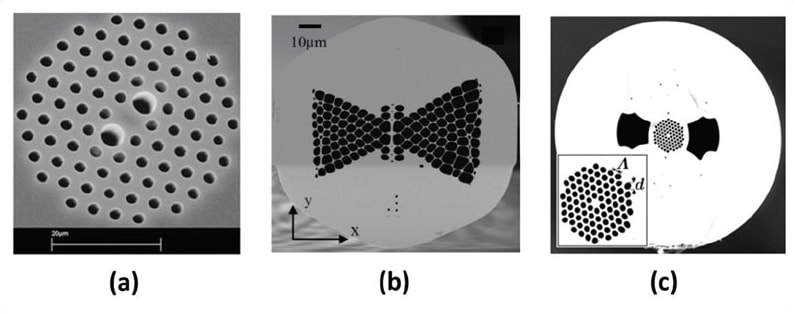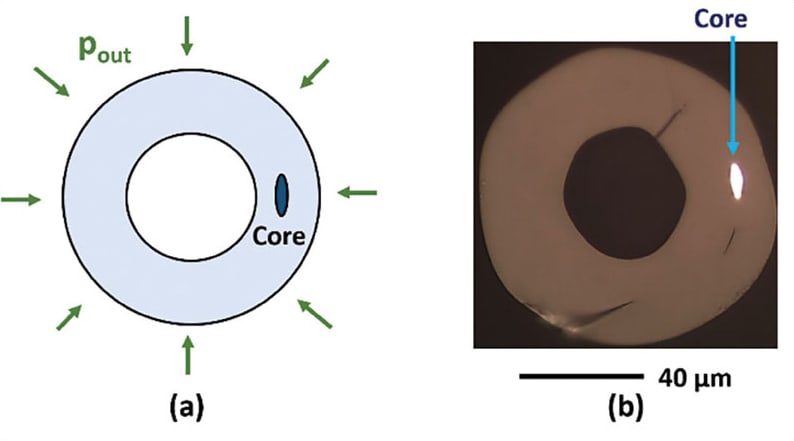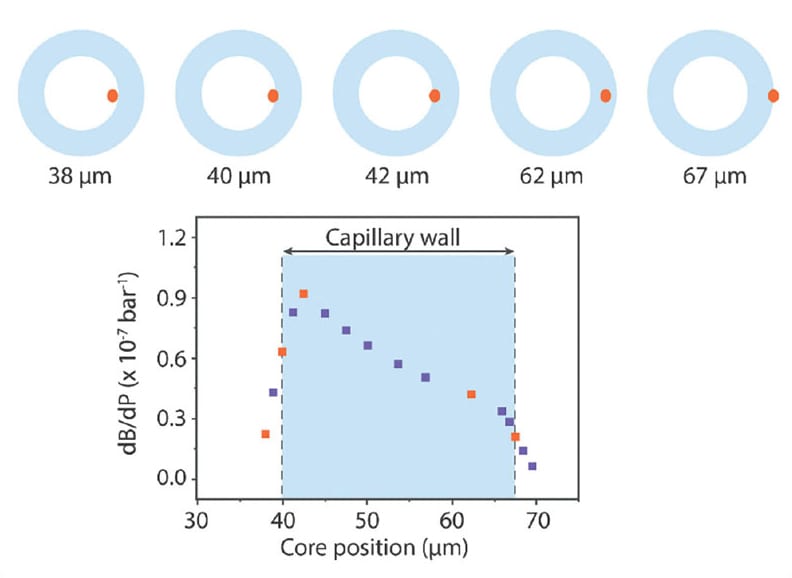Optical fibers. To the average person, the phrase might conjure up an image of glowing hairs twisted artistically into a beautiful shape or fountaining out of a lamp holder. But these light-transmitting silica strands are much more than decoration. Since the initial development of optical fibers in the 1950s, applications have evolved and now include power transmission, communication, imaging, and sensing.
Specifically, they are often used in situations where other sensing techniques can fail. Optical fibers are dielectric, versatile, and with minimum volume, they can be used in environments such as electricity transmission towers, explosive atmospheres, and on the ocean floor, as well as in medical applications.
From Fiber Optics to Pressure Sensors

Standard optical fibers are designed to act in telecommunications setups and, usually, are not useful for sensing purposes. In order to make optical fibers sensitive to a parameter of interest, processing procedures such as the imprinting of fiber gratings are necessary, or specialty microstructured optical fibers can be employed. Microstructured fibers show promise for obtaining highly sensitive pressure sensors used in activities such as medical applications, where technicians and engineers can use them to detect fluid pressure. Figure 1 presents some examples of optical fibers that can act as pressure sensors, as reported in the literature.
Typically, microstructured optical fibers for pressure sensors are configured so that the application of an external load causes an asymmetric stress distribution within the fiber cross section. This, in turn, causes variations in the fiber birefringence — a material property referring to an optically anisotropic refractive index — which can be used for sensing purposes.
“Advantages of optical fiber-based sensors include high sensitivity, electromagnetic immunity, and the possibility of functioning in harsh environments,” says Jonas Osório from the Universidade Estadual de Campinas (UNICAMP). “They are usually very compact, lightweight, and provide great liberty when choosing a sensor’s characteristics.”
But the fiber pressure sensors reported to date have sophisticated micro-structures and usually require several drawings and a delicate manual procedure for assembling the structure. At UNICAMP and at the Instituto de Estudos Avançados (IEAv) in Brazil, work is being done to develop a different type of an optical fiber — an embedded-core capillary fiber — that can act as a highly sensitive pressure sensor. This type of fiber requires a simpler fabrication process that involves a preform preparation method and direct fiber drawing.
A Closer Look at Geometric Characteristics

The embedded-core capillary fiber is a silica capillary tube endowed with a germanium-doped region (the fiber core) placed inside the capillary wall (Figure 2 shows representations of the fiber structure and cross section). The newly developed embedded-core fiber is much simpler than the typical microstructured fibers employed in pressure sensing applications. 4
The research investigated pressure-induced birefringence in microstructured fibers in order to develop and validate a new design concept. It focused on fibers designed to sense hydrostatic pressure — pressure induced by a fluid at rest, such as a body of still water surrounding the sensor. However, the research diverged from existing designs by using capillary fibers (very thin, hollow tubes) instead of solid conventional fibers or structures with a complex air hole pattern.
The goal was to maximize the birefringence dependence on pressure variations, since this would improve the sensing capabilities of the fiber. Beginning from an analytical model, the researchers studied pressure-induced displacements and mechanical stresses in the capillary walls (see Figure 3).

The analytical model showed that applied pressure generates an asymmetrical stress distribution inside the capillary wall due to the capillary structure. Via the photoelastic effect, these stresses cause variations in the material refractive index that are different along the horizontal and vertical axes, generating the desired birefringence.
Maximizing Pressure-Dependent Properties

Using COMSOL Multiphysics® software, the elliptical core — a germanium-doped region inside the silica capillary wall — was added to the mathematical model. Through simulation, the change in modal birefringence as a function of the applied pressure and the location of the core in the capillary wall was obtained (see Figure 4). Modal birefringence describes birefringence of the optical modes that can travel through the fiber core.
The model calculated the effective refractive indices of the fundamental mode for different pressure conditions. This mode occurs when incoming electromagnetic waves are guided through the fiber core. To make the birefringence as dependent on pressure as possible and therefore maximize the sensitivity of the sensor, it was necessary to embed the core area completely within the capillary structure, close to the inner wall. Analyzing the changes in stress distribution for different geometries showed that the birefringence variation derivative with respect to pressure values was higher for fibers with thinner walls and for positions closer to the inner radius of the capillary.
Microstructured Optical Fiber Sensors for Medical
The new sensor’s resolution limit is estimated to be 0.3 bar for a nonoptimized fiber structure. Even with this nonoptimized resolution figure, this configuration may allow the realization of pressure measurements for cancer treatment since the pressure level in this application field may vary within the interval between 0 and 2 bar. 5
Additionally, the simulation results showed that it is feasible to increase the sensor sensitivity by a factor of six (via optimization of the geometric parameters of the fiber; e.g., the capillary wall thickness and the core position within the capillary wall. Therefore, the resolution limit could be reduced to 0.05 bar, which would make the sensor suitable for cardiology and urology applications. Furthermore, the optical fibers are minimally invasive, and they potentially could be made of biocompatible materials. 6
Conclusion
Understanding birefringence pressure dependence enabled simplified production of microstructured optical fibers and confirmed that the design would perform properly as a pressure sensor. Comparing the sensitivity of the new concept to existing, more complicated fiber structures showed that the new design produced similar results but required less assembly work.
The embedded-core fiber provides a new route for obtaining highly sensitive optical fiber pressure sensors, which will make it easier for medical practitioners to evaluate the fluids they extract in real time. The embedded-core fiber presents a new route toward the simplification of optical fiber-based pressure sensors. It is much simpler than typical microstructured fibers, and the highly sensitive sensors are potentially suitable for a number of medical applications, including cardiology, urology, and cancer treatment.
References
- H. Y. Fu, et al. “Pressure Sensor Realized with Polarization- Maintaining Photonic Crystal Fiber-Based Sagnac Interferometer,” Applied Optics, 47, 15, 2835–2839, 2008.
- A. Anuskiewicz, et al., “Sensing Characteristics of the Rocking Filters in Microstructured Fibers Optimized for Hydrostatic Pressure Measurements,” Optics Express, 20, 21, 23320–23330, 2012.
- J. H. Osório, et al., “Photonic-Crystal Fiber-Based Pressure Sensor for Dual Environment Monitoring,” Applied Optics, 53, 17, 3668–3672, 2014.
- Jonas H. Osório, et al., “Simplifying the Design of Microstructured Optical Fibre Pressure Sensors,” Scientific Reports, 7, 2017.
- Sven Poeggel, et al., “Optical Fibre Pressure Sensors in Medical Applications,” Sensors 2015, 15(7), 17115–17148.
- F. G. Omenetto and D. L. Kaplan, “A New Route for Silk", Nature Photonics 2, 2008, 641–643.
This article was written with the help of the Brazilian researchers Marcos A. R. Franco from the Instituto de Estudos Avançados (IEAv) and Jonas Osório and Cristiano M. B. Cordeiro from the Institute of Physics at Universidade Estadual de Campinas (UNICAMP). The research team also included Valdir Serrão from IEAv and Giancarlo Chesini from UNICAMP. For more information, visit here .



